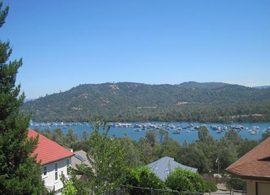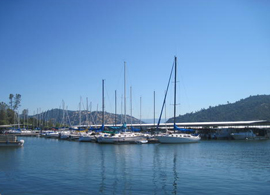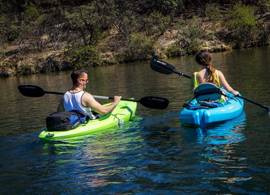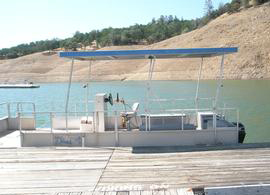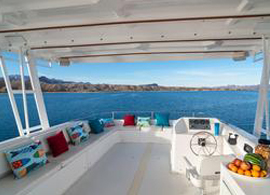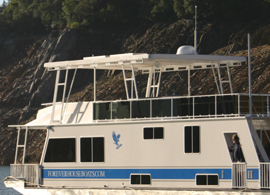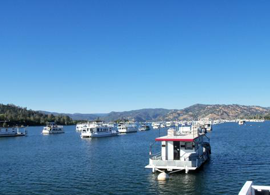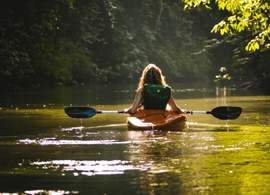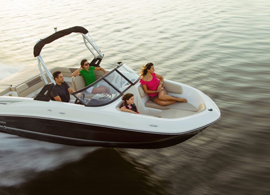Nice place to launch your boat. Fun place near the boat ramp that over looks the house boasts and a decent spot to have a picnic. Bathrooms are clean, the staff was nice. Over all am awesome place to launch and motor around.
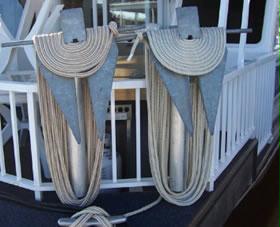 Navigating the open lake is half of the fun of any houseboat trip. Our houseboats are designed to move gracefully through the water so that everyone can enjoy a 360-degree view of the lake and shoreline.
Navigating the open lake is half of the fun of any houseboat trip. Our houseboats are designed to move gracefully through the water so that everyone can enjoy a 360-degree view of the lake and shoreline.
There is no boat operation allowed at night, so finding a location to anchor or stake your houseboat is key. Once you find a suitable location, you can set up your campsite and enjoy the shoreline during the evenings and throughout your houseboat vacation.
Your houseboat will be equipped with stakes or anchors designed for the beach types on the lake. They are stored on the forward posts for easy retrieval. Since houseboats are quite long, the ropes are already tied to the aft (rear) cleat of your boat.
Houseboater's Tip - A powerboat or personal watercraft (a jetski) comes in handy for scouting beaches and finding the right spot to tie up since they are more nimble near the shoreline than the houseboat.
Before beaching your houseboat, you will first choose a spot out of the main channel and high-traffic areas, where there are no underwater hazards. A nice wide, sandy beach with plenty of room for setting up camp is what you're shooting for.
Once you've found the right spot to beach you will prepare the houseboat for beaching by turning off the generator (to avoid sucking sand or matter into the cooling intake). Then, from the helm (not the flying bridge if your houseboat is so equipped) you will approach the shoreline with your motors running typically at 800 to 1000 RPMs. At this low speed you will then ease your houseboat up to the shoreline - watching for any underwater hazards or unexpected shallow areas.
Once you have beached your houseboat, you will keep your motors running at this low speed until you have completed securing the houseboat. It is important that the operator stays at the helm until the boat is secured, and that passengers are not on or around the back deck of the boat when the motors are running and the boat is parked.
Start securing your houseboat by first throwing the ropes to the beach and then move your stakes or anchors from the front of the houseboat to positions approximately 45 degrees from the boat (see illustration). Use the provided hammer or shovel to either pound in your stakes, or dig anchor holes. Sturdy work gloves are a good idea - you may want to bring your own to be sure you have them handy. If it is windy, start from the prevailing side - the direction from which the wind is coming from. This will help keep the houseboat in position during tie down. If the wind pushed the houseboat out of position, during tie-down, the operator can steer the motors and apply a slight amount of throttle to straighten the boat.
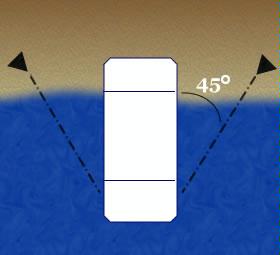 Staking Your Houseboat
Most lakes will use very strong steel stakes to tie down the houseboat. Pound in the stakes at an angle pointing away from the boat to provide the most leverage on shore. Tie the rope to the stake. When all stakes are set, retie them as tightly as possible. Very long ropes will have some slack from the weight of the rope.
Staking Your Houseboat
Most lakes will use very strong steel stakes to tie down the houseboat. Pound in the stakes at an angle pointing away from the boat to provide the most leverage on shore. Tie the rope to the stake. When all stakes are set, retie them as tightly as possible. Very long ropes will have some slack from the weight of the rope.
Using Sand Anchors
If you’re visiting Lake Powell, the houseboats will be tied down with large sand anchors instead of stakes. To set the anchors, you will need to dig a large hole 2 to 3 feet deep and wide enough to accommodate the anchor. Drop in the anchor and tie on the rope. Set the anchors by alternately pulling and tightening the ropes. Fill the holes with sand to cover the anchor - you can even pour water over the sand to "set" the anchors if you wish. Tighten all the ropes at the anchors until the houseboat is secure.
You can use the houseboat motors to further tighten the ropes by swinging the rear of the boat slightly toward the rope being tightened. Using your boat motors to do the work for you makes rope tightening easy and ensures that your boat is secure. Only after all ropes are secure should you turn the motors off. It is a good idea to clearly mark your stakes and anchors if they are showing above ground - even cover them with something so that they are easily visible in the dark.
Windy Conditions If it becomes windy and you are concerned that your houseboat may come loose, remember you can use the motors to provide additional resistance to the wind. Again, be sure no one is on or near the rear deck of the houseboat when the motors are in operation on the shore. It is also important to be aware that fluctuating lake levels may require you to move the houseboat higher or lower on the beach each day, adjusting the ropes accordingly.
What People Are Saying
A really nice place to rent a boat. The staff there are extraordinarily kind and helpful.
Ruwen Liu
The staff were all friendly. They got me registered and out on a well maintained patio boat in no time at all. I would certainly return and refer them to others.
John Chancellor
Super helpful staff. Nice place to go. Clean and safe.
Amanda Horton
Good spot for some bass fishing on the weekend. There's a small store here in case you forgot something too.
